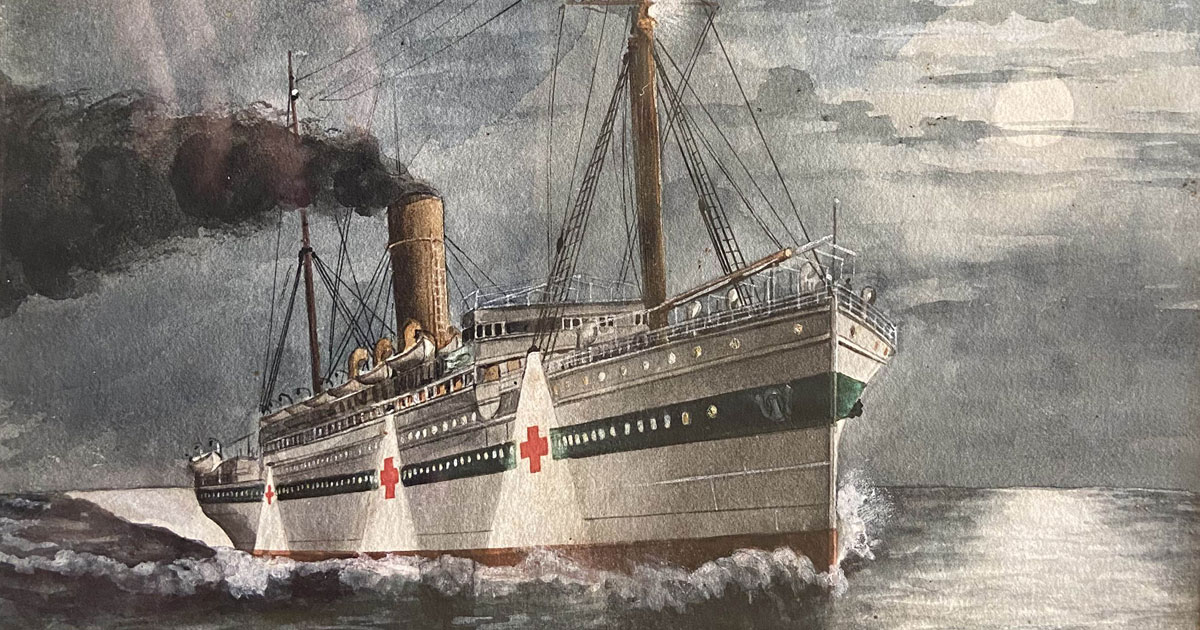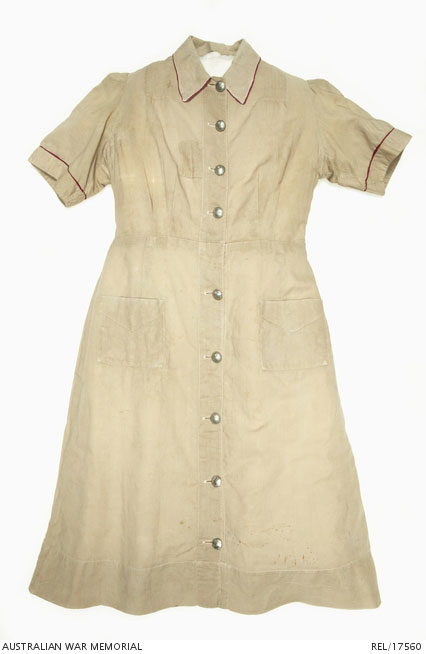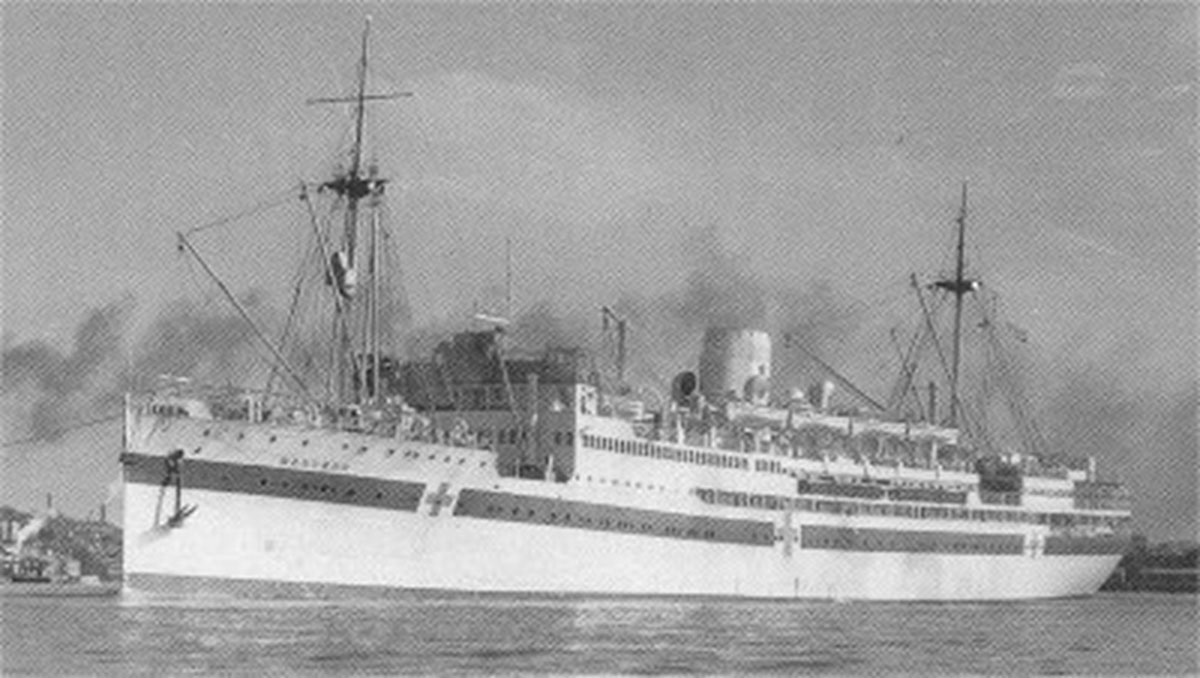
Amongst the exhibits in the Australian War Memorial is a beige cotton working dress with links to the bombing of Darwin in 1942. The dress has nine metal buttons, each bearing the insignia of the Australian Military Forces and sleeves edged with narrow, now faded, cerise bands.

Above the large, practical front pockets and loose pleats is an original hand-sewn repair, marking the site where its bearer, Lieutenant Joan Sommerville, a physiotherapist aboard the Hospital Ship HMAS Manunda, sustained serious shrapnel injuries on 19 February 1942 during the bombing of Darwin. Her colleague, Sister Margaret de Mestre, was fatally wounded and died from her wounds.
Sailing from Darling Harbour, HMAS Manunda arrived in Darwin on 14 January 1942.
Over the next five weeks the medical staff visited military hospitals in the Darwin area and watched the build-up of defensive troops as Australia responded to the Japanese advance through the Indonesian archipelago.
Australian forces were reinforced by US ships and Kittyhawk squadrons at Darwin airfield.
For those on the Manunda, the days were filled with evacuation drills, training of nursing orderlies and adjusting to the routines of life on board the 9115-ton steamer.
Over the next few weeks, anxieties about Japan increased, and the Australian War Cabinet ordered the evacuation of all ‘non-essential’ people from Darwin.
Although more than 3,000 civilian personnel remained, most of the women, children and infirm had left prior to Christmas.
The fall of Singapore
On 15 February, Darwin received news of the fall of Singapore. The war was becoming perilously close to Australia’s northern coastline.
On 19 February 1942, Lieutenant Joan Holland Somerville, who had joined the Army as a 25-year-old physiotherapist, was amongst the medical and nursing staff, on board HMAS Manunda.
HMAS Manunda was the second-largest ship in harbour and clearly marked as a hospital ship with visible red crosses.
Manunda sat in Darwin Harbour, virtually undefended and dangerously close to two other vessels, the Neptuna, packed with explosives, and the USS Peary, a destroyer and primary Japanese target.
The first reports of a Japanese approach were received by Darwin radio at 0930.
The bombing of Darwin begins
A flight of Japanese Zero fighters crossed the Timor Sea, and within minutes explosives and incendiary bombs hailed down on the decks on the hapless fleet and churned the Darwin waters into a whirlpool.
A single Japanese Zero flew in at low altitude, with its bomb bays open, and dropping a well-aimed incendiary into Manunda’s aft hatch. The bomb went through the skylight of a lounge that was used as a music room on ‘B’ Deck and turned the room into a mass of twisted debris.
“All that remained of a grand piano were a few strands of twisted wire, and the steel bulkheads and deck were buckled as though made of tin.”
The trapped ships still at anchor were unable to escape. Surrounded by burning ships, and listing herself, as a result of a ‘near miss’ aimed at the adjacent USS Peary, the decks of HMAS Manunda were sprayed with shrapnel.
A dense,foul-smelling black wall of black smoke drifted across the harbour and the sea became thick with oil and debris. Hammering anti-aircraft batteries did little to deter the Japanese, many of whom were veterans of attacks on Pearl Harbor.
“By this time fire had broken out, the medical and nursing staff quarters being totally destroyed. Men were flung overboard by the explosion and some of the life-boats were manned by the hospital crew to rescue injured men from the water”
Twelve members of the ship’s crew and hospital staff, including Sister de Mestre and Captain Hocking, the dentist, were killed on the Manunda and 18 seriously wounded.
There were also many other minor wounds and others taken on board from the burning wharves and adjacent ships.
Joan was critically injured. She sustained multiple shrapnel wounds that tore through her working dress.
Her 26-year-old friend, Sister Margaret de Mestre, who had served with Joan in Egypt, was not so fortunate. Hit in the back by shrapnel, Margaret died of her wounds two hours later.
The HMAS Manunda, damaged but not destroyed
Although her navigational equipment was wrecked, HMAS Manunda’s main engines were undamaged and she was able to proceed to sea.
Despite the damage, she continued to function as a hospital ship:
The lifts between the decks were no longer functioning, but patients could be carried up and down the narrow companion ways. At the aft end of the ship surgeons worked continuously to treat the injured and the dying.

The white hulled ship, conspicuous with its large red crosses on the funnels and deck, became a floating casualty clearing station, as the wounded were brought to her side, many of them suffering from terrible burns from the burning oil.
Eight days later, HMAS Manunda limped into Fremantle harbour to deliver the wounded.
Joan Somerville underwent surgery for her wounds, but did not return to the ship. She was medically discharged from service on 1 March 1942.
After the Japanese surrender in 1945, HMAS Manunda was dispatched to Singapore to repatriate ex-POWs and civilian internees who had been imprisoned in Changi Prison.